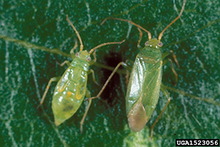Quick facts
- Honeylocust plant bugs feed on honeylocust trees.
- Trees grown in exposed, sunny locations are more prone to plant bug attack.
- Varieties of honeylocust with yellow leaves are more attractive to honeylocust plant bugs than the ones with green leaves.
- Young, recently transplanted trees are more susceptible to damage.
- In most cases, feeding only affects the tree’s appearance. Tolerate the damage when possible.
How to identify honeylocust plant bugs
- Honeylocust plant bugs are oval and range up to 1/8 inch long as nymphs and ¼ inch long as adults.
- Both nymphs and adults are pale green and blend in with leaves.
- Adults have fully developed wings.
- Nymphs are very active and resemble large mobile aphids.
Life cycle
- Honeylocust plant bugs have one generation per year.
- Eggs survive winter under the bark of twigs and hatch in spring, when the leaf buds start opening up.
- The newly hatched nymphs feed on new leaves until June.
- Then they mate and lay eggs where they remain until the following spring.
- It takes about one month for plant bugs to mature from egg to adult.
- Adults are rarely seen after late July.
Damage caused by honeylocust plant bugs
- These plant bugs feed on the underside of leaves with a needle-like mouthpart (stylet).
- This feeding creates tiny, circular and discolored patches on the leaf (stippling).
- Damaged leaves remain small and become twisted and dwarfed.
- The damage looks like herbicide injury. But honeylocust plant bug damage is seen on new leaves all across the plant, and herbicide damage occurs only on the side where herbicide was sprayed.
- Honeylocust plant bugs also produce small, shiny, dark, varnish-like droppings on the undersides of infested leaves.
In most cases, damaged leaves remain on the tree until the fall season. If the damage is severe, the leaves will fall off, especially in younger trees.
How to protect your trees
Most honeylocust plant bug damage is just cosmetic and does not impact the health of trees. The best approach in most cases for tree owners is to keep trees healthy and tolerate the damage. If there has been a history of high numbers of bugs, you may need to treat honeylocust plant bugs.
Consider hiring a tree care professional to protect your trees, especially large ones, from plant bugs. They have the training and experience to successfully manage insect problems. See How to hire a tree care professional.
Check for plant bugs in early spring
If there has been problems with damage in the past, check trees for honeylocust bugs in the spring before or as leaf buds open. If insect numbers are high enough, you may need to use insecticide.
Using pesticides
Pesticides should be applied only if it is necessary to protect the appearance of trees or when the health of trees are at risk.
- Good coverage and timing is critical.
- Spray the undersides of the leaves where plant bugs are normally found
The best time to apply a pesticide is when plant bugs are first hatching, at about bud break.
- Insecticidal soap is a low impact pesticide that can be effective against nymphs.
- The spray has to come in direct contact with the nymphs to be effective.
- Repeat applications of these soaps can be necessary.
- Broad spectrum, longer lasting pesticides are also available. Common examples include:
- Pyrethroids , like permethrin and bifenthrin
- Carbaryl
- Acephate
Be careful while using broad spectrum pesticides because they may kill beneficial insects along with the honeylocust plant bugs. Broad-spectrum pesticides can kill the predators of spider mites, which can lead to a spider mite outbreak.
Honeylocust flowers are very attractive to bees when they are blooming. Avoid applying imidacloprid and dinotefuran as they are very toxic to bees.
CAUTION: Mention of a pesticide or use of a pesticide label is for educational purposes only. Always follow the pesticide label directions attached to the pesticide container you are using. Remember, the label is the law.
Reviewed in 2019



